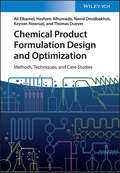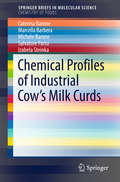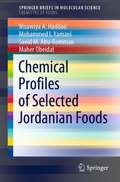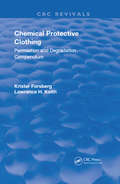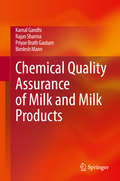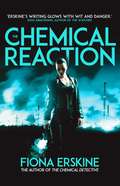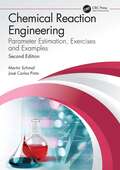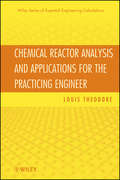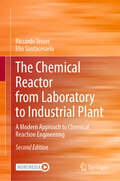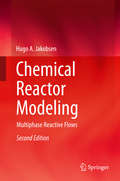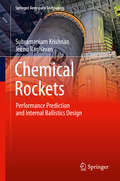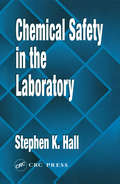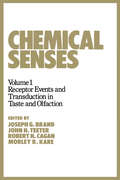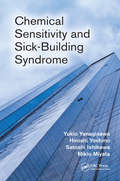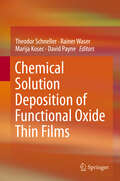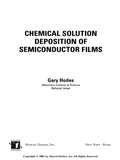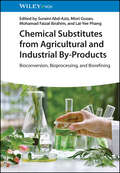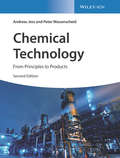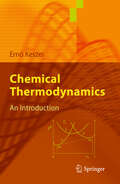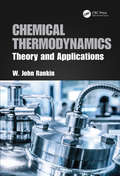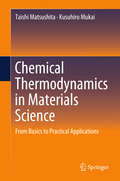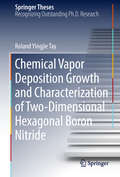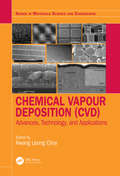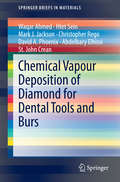- Table View
- List View
Chemical Product Formulation Design and Optimization: Methods, Techniques, and Case Studies
by Ali Elkamel Hesham Alhumade Navid Omidbakhsh Keyvan Nowruzi Thomas DueverChemical Product Formulation Design and Optimization Explore the cutting-edge in chemical product formulation and design In Chemical Product Formulation Design and Optimization: Methods, Techniques, and Case Studies, a team of renowned technologists and engineers delivers a practice guide to chemical product design. Offering real-world case studies for disinfectant formulation, the optimization of defined media, and the formulation of biocomposites, the book contains introduction to the current product design process. In addition to the background of related statistical techniques, readers will find: Clear illustrations, figures, and tables that improve understanding and retention of critical topics Thorough introductions to the mathematical principles of chemical product design A complete examination of intellectual property considerations in the chemical product design process Ideal for process and chemical engineers, Chemical Product Formulation Design and Optimization: Methods, Techniques, and Case Studies is a must-read resource for professionals in the pharmaceutical and cosmetics industry as well as chemical engineers working in the food, paint, and dye industries who seek a one-stop resource that includes the latest advances in chemical product formulation.
Chemical Profiles of Industrial Cow’s Milk Curds (SpringerBriefs in Molecular Science)
by Salvatore Parisi Caterina Barone Izabela Steinka Marcella Barbera Michele BaroneThis Brief explores the chemistry and production technology of a cheese precursor: the cow's milk curd. It explains how different coagulation and treatment methods can be used to obtain various types of cheeses. Parameters such as the type of used milk, the coagulation method, pH value, color, and microbial fermentation have a profound impact on the resulting curd properties, and hence on the cheese. The authors discuss some of the most important parameters, and how their modification can lead to a variety of cheese and dairy products. This Brief also addresses the question, if cheese makers can standardize their production procedures, and what role chemistry may play in that. Another important point addressed here are the sources of failures in the curd production, e. g. in packaging systems. Readers will find selected examples of helpful analytical techniques for studying and evaluating curd quality, and for monitoring the chemical evolution of selected chemical substances or protein aggregation.
Chemical Profiles of Selected Jordanian Foods (SpringerBriefs in Molecular Science)
by Moawiya A. Haddad Mohammed I. Yamani Saeid M. Abu-Romman Maher ObeidatThis book provides an overview of various traditional Middle Eastern food products and beverages and investigates their chemical, microbial and physical profiles. The authors selected 5 traditional Jordanian products that represent the region’s historical foods and beverages and examined them with a focus on their chemical composition and preparation, as well as features such as food safety and quality management. The first chapter provides a general introduction to traditional foods in Jordan. Subsequent chapters then shed light on specific product classes, including Shaneenah, a popular fermented dairy drink; Mujaddara and Rashoof, two products based on lentils; Kebab products; soft cheese; and Muhallabiaah, a traditional milk pudding. This book offers a valuable reference guide to many traditional/historical products in the Middle East, and due to region’s historical influence on the Mediterranean diet, it is also of interest to researchers in southern Europe.
Chemical Protective Clothing: Permeation and Degradation Compendium (Routledge Revivals)
by Krister Forsberg Lawrence H. KeithFirst Published in 1995. The three most important things to evaluate when selecting Chemical Protective Clothing (CPC) are: evidence of degradation of the garment exposed to a chemical; breakthrough time; and permeation rate. Because proper CPC selection must be based on permeation and degradation tests performed upon specific manufacturer products, an information source that enables you to access test results quickly and easily is needed. "Chemical Protective Clothing Permeation and Degradation Compendium" aims to be that source.
Chemical Quality Assurance of Milk and Milk Products
by Kamal Gandhi Rajan Sharma Priyae Brath Gautam Bimlesh MannThis book discusses quality-related aspects of milk and milk products, covering the various analytical procedures for testing the quality and composition. It also describes the adulteration of milk and milk products and the common as well as advanced techniques used to detect such adulteration. Further, the book examines food laws, guidelines and regulations laid down by FSSAI, CODEX, ISO, IDF and USFDA, and addresses the functioning of a number of international and national organizations, including the WTO, Codex Alimentarius Commission, and BIS. Familiarizing readers with the concepts of QC, TQM, PDCA cycle and related concepts of quality assurance, the book also provides information on other topics that indirectly contribute to the quality of milk and milk products, like the calibration of milk testing equipment, quality of water used in milk processing and the standardization of various chemicals used for testing. This book is a valuable resource for researchers and industry professionals dealing with dairy products.
The Chemical Reaction
by Fiona ErskineAs Jaq is pulled further into a murky underworld of deceit and corruption, things take an explosive turn… After escaping almost certain death amidst the ruins of Chernobyl, Jaq finds herself in even hotter water. Deep in debt, she decides to take on a risky contract in China. But when her old student and the chemical factory she was meant to be investigating both mysteriously disappear, she realises nothing is as it seems. From fraudulent art auctions in London to a troupe of male strippers in Shanghai, the mystery of the vanishing factory begins to look ever more complicated as the days pass. Can Jaq work out what happened – and whether it has anything to do with her nemesis Frank Good – before time runs out?
Chemical Reaction Engineering: Parameter Estimation, Exercises and Examples
by Martin Schmal José Carlos PintoThe first English edition of this book was published in 2014. This book was originally intended for undergraduate and graduate students and had one major objective: teach the basic concepts of kinetics and reactor design. The main reason behind the book is the fact that students frequently have great difficulty to explain the basic phenomena that occur in practice. Therefore, basic concepts with examples and many exercises are presented in each topic, instead of specific projects of the industry. The main objective was to provoke students to observe kinetic phenomena and to think about them. Indeed, reactors cannot be designed and operated without knowledge of kinetics. Additionally, the empirical nature of kinetic studies is recognized in the present edition of the book. For this reason, analyses related to how experimental errors affect kinetic studies are performed and illustrated with actual data. Particularly, analytical and numerical solutions are derived to represent the uncertainties of reactant conversions in distinct scenarios and are used to analyze the quality of the obtained parameter estimates. Consequently, new topics that focus on the development of analytical and numerical procedures for more accurate description of experimental errors in reaction systems and of estimates of kinetic parameters have been included in this version of the book. Finally, kinetics requires knowledge that must be complemented and tested in the laboratory. Therefore, practical examples of reactions performed in bench and semi-pilot scales are discussed in the final chapter. This edition of the book has been organized in two parts. In the first part, a thorough discussion regarding reaction kinetics is presented. In the second part, basic equations are derived and used to represent the performances of batch and continuous ideal reactors, isothermal and non-isothermal reaction systems and homogeneous and heterogeneous reactor vessels, as illustrated with several examples and exercises. This textbook will be of great value to undergraduate and graduate students in chemical engineering as well as to graduate students in and researchers of kinetics and catalysis.
Chemical Reactor Analysis and Applications for the Practicing Engineer
by Louis TheodoreThis books format follows an applications-oriented text and serves as a training tool for individuals in education and industry involved directly, or indirectly, with chemical reactors. It addresses both technical and calculational problems in this field. While this text can be complimented with texts on chemical kinetics and/or reactor design, it also stands alone as a self-teaching aid. The first part serves as an introduction to the subject title and contains chapters dealing with history, process variables, basic operations, kinetic principles, and conversion variables. The second part of the book addresses traditional reactor analysis; chapter topics include batch, CSTRs, tubular flow reactors, plus a comparison of these classes of reactors. Part 3 keys on reactor applications that include non-ideal reactors: thermal effects, interpretation of kinetic data, and reactor design. The book concludes with other reactor topics; chapter titles include catalysis, catalytic reactors, other reactions and reactors, and ABET-related topics. An extensive Appendix is also included
The Chemical Reactor from Laboratory to Industrial Plant: A Modern Approach to Chemical Reaction Engineering
by Riccardo Tesser Elio SantacesariaThis second edition presents updated key concepts and exercises in chemical reaction engineering. While retaining the foundational structure of the first edition, this graduate textbook offers 2 new chapters devoted to polymerization reactions and reactors, and to bioreactors, and provides a complete and more suitable overview of the field for students and researchers of Chemical Reaction Engineering Sciences. The Preface of this edition has been rewritten to justify the changes conducted since the first edition. The subsequent chapters introduce students to the concepts behind the successful design and operation of chemical reactors, with an emphasis on qualitative arguments, simple design methods, graphical procedures, and frequent comparison of capabilities of the major reactor types. These chapters were updated and/or enriched with new exercises, and particular attention was given to the following topics: Chapter 2: Expanded Vapour-Liquid Equilibria (VLE) in multi-component systems with new exercises, including flash separation with reaction. Chapter 3: Deepened surface acidity distribution of heterogeneous catalysts with a new exercise. Chapters 4 & 5: Enlarged exercises with further calculations, plots, and new solved exercises. Chapter 6: Enriched with a new exercise on effectiveness factor calculation, covering mass, heat, and momentum transport laws and their relationship with chemical kinetics. Chapter 7: Added exercise to determine concentration profiles in the liquid film for gas-liquid reactions at different reaction rates. Chapter 8: New chapter on polymers and polymerization reactors, detailing mechanisms and kinetics with solved examples and exercises for various polymerization types. Chapter 9: New chapter on Bioreactors, covering the evolution of kinetic models for fermentation processes, including metabolic and cybernetic models applied to baker yeast and bioethanol production, with examples and solved exercises. The authors conducted a comprehensive revision of all the MATLAB code exercises to ensure they aligned with current learning objectives and described in detail the mathematical strategy adopted, particularly for the more complex problems. With expanded content, practical exercises, and new chapters, this textbook equips students and professionals alike with the knowledge and tools to excel in chemical and industrial engineering.
Chemical Reactor Modeling: Multiphase Reactive Flows
by Hugo A. JakobsenChemical Reactor Modeling closes the gap between Chemical Reaction Engineering and Fluid Mechanics The second edition consists of two volumes: Volume 1: Fundamentals. Volume 2: Chemical Engineering Applications In volume 1 most of the fundamental theory is presented. A few numerical model simulation application examples are given to elucidate the link between theory and applications. In volume 2 the chemical reactor equipment to be modeled are described. Several engineering models are introduced and discussed. A survey of the frequently used numerical methods, algorithms and schemes is provided. A few practical engineering applications of the modeling tools are presented and discussed. The working principles of several experimental techniques employed in order to get data for model validation are outlined. The monograph is based on lectures regularly taught in the fourth and fifth years graduate courses in transport phenomena and chemical reactor modeling and in a post graduate course in modern reactor modeling at the Norwegian University of Science and Technology, Department of Chemical Engineering, Trondheim, Norway. The objective of the book is to present the fundamentals of the single-fluid and multi-fluid models for the analysis of single and multiphase reactive flows in chemical reactors with a chemical reactor engineering rather than mathematical bias. Organized into 13 chapters, it combines theoretical aspects and practical applications and covers some of the recent research in several areas of chemical reactor engineering. This book contains a survey of the modern literature in the field of chemical reactor modeling.
Chemical Rockets: Performance Prediction and Internal Ballistics Design (Springer Aerospace Technology)
by Subramaniam Krishnan Jeenu RaghavanThe purpose of this book is to discuss, at the graduate level, the methods of performance prediction for chemical rocket propulsion. A pedagogical presentation of such methods has been unavailable thus far and this text, based upon lectures, fills this gap. The first part contains the energy-minimization to calculate the propellant-combustion composition and the subsequent computation of rocket performance. While incremental analysis is for high performance solid motors, equilibrium-pressure analysis is for low performance ones. Both are detailed in the book's second part for the prediction of ignition and tail-off transients, and equilibrium operation. Computer codes, adopting the incremental analysis along with erosive burning effect, are included. The material is encouraged to be used and presented at lectures. Senior undergraduate and graduate students in universities, as well as practicing engineers and scientists in rocket industries, form the readership.
Chemical Safety in the Laboratory
by Stephen K. HallNothing is more important to an organization than the health and safety of its workers. The managerial effectiveness of any health and safety program is judged on the basis of how well it prevents injuries and ill health. Chemical Safety in the Laboratory provides a proven approach to implementing and maintaining an effective chemical safety program for laboratories in hospital, industrial, and educational settings. Based on 20 years of experience managing and auditing chemical safety programs, the author discusses the OSHA Laboratory Standard and the Chemical Hygiene Plan, provides guidelines for the effective use of personal protective equipment, and details chemical emergency planning and response procedures. He also outlines a 19-step decontamination procedure for emergency responders. Employee chemical exposure monitoring and victim handling procedures are among the other major topics covered in this essential guide.
Chemical Senses: Receptor Events and Transduction in Taste and Olfaction
by Joseph G. BrandThis book focuses on the initial biochemical and biophysical aspects of taste and olfaction. It is intended for a wide audience, both those already familiar with the chemical senses and those biochemists and neuro-biologists interested in gaining an appreciation of this rapidly expanding discipline.
Chemical Sensitivity and Sick-Building Syndrome
by Hiroshi Yoshino Mikio Miyata Satoshi Ishikawa Yukio YanagisawaWritten by multidisciplinary experts in medicine, chemistry, and architecture, this book examines chemical sensitivity (CS). In 15 chapters fitted to 15 lectures, it discusses not only the medical explanation, but also the environmental factors of this hypersensitive reaction, such as chemistry and architectural aspects. The book overviews pollution-induced diseases such as Minamata Disease. It also points out the similarity of modern hypersensitivity syndromes to historical pollution diseases from the viewpoints of not only natural scientific aspects, but also social understanding of the disease.
Chemical Sensors
by Dnyandeo Karbhari PawarChemical sensors contain two basic functions: recognition and transduction, and provide real-time information about substances rather than physical quantities. Such devices are extensively utilized for various applications in diverse fields. The book focuses on the physical, chemical, optical, and electrical working mechanisms of different types of sensors integrated with various smart nanomaterials and composites. The mesmerizing properties of numerous materials and their fruitful applications for detecting numerous chemical parameters are discussed here. The book provides recent progress in the chemical sensors field and connects materials, physics, chemistry, and engineering, and therefore, is suitable for engineers, industrial, and academic researchers.
Chemical Solution Deposition of Functional Oxide Thin Films
by David Payne Rainer Waser Theodor Schneller Marija KosecThis is the first text to cover all aspects of solution processed functional oxide thin-films. Chemical Solution Deposition (CSD) comprises all solution based thin- film deposition techniques, which involve chemical reactions of precursors during the formation of the oxide films, i. e. sol-gel type routes, metallo-organic decomposition routes, hybrid routes, etc. While the development of sol-gel type processes for optical coatings on glass by silicon dioxide and titanium dioxide dates from the mid-20th century, the first CSD derived electronic oxide thin films, such as lead zirconate titanate, were prepared in the 1980's. Since then CSD has emerged as a highly flexible and cost-effective technique for the fabrication of a very wide variety of functional oxide thin films. Application areas include, for example, integrated dielectric capacitors, ferroelectric random access memories, pyroelectric infrared detectors, piezoelectric micro-electromechanical systems, antireflective coatings, optical filters, conducting-, transparent conducting-, and superconducting layers, luminescent coatings, gas sensors, thin film solid-oxide fuel cells, and photoelectrocatalytic solar cells. In the appendix detailed "cooking recipes" for selected material systems are offered.
Chemical Solution Deposition Of Semiconductor Films
by Gary HodesDiscussing specific depositions of a wide range of semiconductors and properties of the resulting films, Chemical Solution Deposition of Semiconductor Films examines the processes involved and explains the effect of various process parameters on final film and film deposition outcomes through the use of detailed examples. Supplying experimental results and practical examples, the book covers fundamental scientific principles underlying the chemical deposition process, various mechanisms involved in deposition, films of all the semiconductors deposited by this technique, and the use of semiconductor films in photovoltaics, photoelectrochemical properties, and size quantization effects.
Chemical Substitutes from Agricultural and Industrial By-Products: Bioconversion, Bioprocessing, and Biorefining
by Suraini Abd-Aziz; Misri Gozan; Mohamad Faizal Ibrahim; Lai-Yee PhangChemical Substitutes from Agricultural and Industrial By-Products A comprehensive resource presenting different manufacturing bioprocesses of chemical substitutes, from agricultural and industrial by-products to value-added biorefinery products Chemical Substitutes from Agricultural and Industrial By-Products: Bioconversion, Bioprocessing, and Biorefining discusses the biorefinery of chemical substitutes from agricultural and industrial by-products, covering the consolidated bioconversion, bioprocessing, and downstream process of the significant chemical substitutes produced. In each chapter, the individual aspects of bioconversion, bioprocessing, and downstream process of chemical substitutes produced from selected agricultural and industrial by-products to selected chemical substitutes are discussed. The text includes helpful case studies of specific processes to aid in reader comprehension. Edited by four highly qualified academics, Chemical Substitutes from Agricultural and Industrial By-Products: Bioconversion, Bioprocessing, and Biorefining includes information on: Common substitutes for chemicals obtained from biomass of agricultural wastes and industrial by-products, including antioxidants, oleoresin, nanocarbon materials, enzymes, essential oils, bio-bleaching agents, and biosugars Alternative substitutes, including biofertilizers, cocoa butter substitutes, bio-succinic acids, furfural derivatives, levulinic acids, and cellulases Economic calculations, such as cost analysis, of different bioprocesses to analyze their feasibility in business and general industry Environmental impact analysis of chemical substitutes from agricultural and industrial by-products for a sustainable agriculture system Enabling readers to create a change in the perception of the waste agricultural biomass from waste to resource, Chemical Substitutes from Agricultural and Industrial By-Products: Bioconversion, Bioprocessing, and Biorefining is an essential resource for biotechnologists, chemists in industry, natural products chemists, process engineers, chemical engineers, and environmental chemists.
Chemical Technology: From Principles to Products (Coursesmart Ser.)
by Andreas Jess Peter WasserscheidA fully updated edition of a popular textbook covering the four disciplines of chemical technology?featuring new developments in the field Clear and thorough throughout, this textbook covers the major sub-disciplines of modern chemical technology?chemistry, thermal and mechanical unit operations, chemical reaction engineering, and general chemical technology?alongside raw materials, energy sources and detailed descriptions of 24 important industrial processes and products. It brings information on energy and raw material consumption and production data of chemicals up to date and offers not just improved and extended chapters, but completely new ones as well. This new edition of Chemical Technology: From Principles to Products features a new chapter illustrating the global economic map and its development from the 15th century until today, and another on energy consumption in human history. Chemical key technologies for a future sustainable energy system such as power-to-X and hydrogen storage are now also examined. Chapters on inorganic products, material reserves, and water consumption and resources have been extended, while another presents environmental aspects of plastic pollution and handling of plastic waste. The book also adds four important processes to its pages: production of titanium dioxide, silicon, production and chemical recycling of polytetrafluoroethylene, and fermentative synthesis of amino acids. -Provides comprehensive coverage of chemical technology?from the fundamentals to 24 of the most important processes -Intertwines the four disciplines of chemical technology: chemistry, thermal and mechanical unit operations, chemical reaction engineering and general chemical technology -Fully updated with new content on: power-to-X and hydrogen storage; inorganic products, including metals, glass, and ceramics; water consumption and pollution; and additional industrial processes -Written by authors with extensive experience in teaching the topic and helping students understand the complex concepts Chemical Technology: From Principles to Products, Second Edition is an ideal textbook for advanced students of chemical technology and will appeal to anyone in chemical engineering.
Chemical Thermodynamics: An Introduction
by Ernö KeszeiThis course-derived undergraduate textbook provides a concise explanation of the key concepts and calculations of chemical thermodynamics. Instead of the usual 'classical' introduction, this text adopts a straightforward postulatory approach that introduces thermodynamic potentials such as entropy and energy more directly and transparently. Structured around several features to assist students' understanding, Chemical Thermodynamics : Develops applications and methods for the ready treatment of equilibria on a sound quantitative basis.Requires minimal background in calculus to understand the text and presents formal derivations to the student in a detailed but understandable way.Offers end-of-chapter problems (and answers) for self-testing and review and reinforcement, of use for self- or group study.This book is suitable as essential reading for courses in a bachelor and master chemistry program and is also valuable as a reference or textbook for students of physics, biochemistry and materials science.
Chemical Thermodynamics: Theory and Applications
by W.J. RankinThis book develops the theory of chemical thermodynamics from first principles, demonstrates its relevance across scientific and engineering disciplines, and shows how thermodynamics can be used as a practical tool for understanding natural phenomena and developing and improving technologies and products. Concepts such as internal energy, enthalpy, entropy, and Gibbs energy are explained using ideas and experiences familiar to students, and realistic examples are given so the usefulness and pervasiveness of thermodynamics becomes apparent. The worked examples illustrate key ideas and demonstrate important types of calculations, and the problems at the end of chapters are designed to reinforce important concepts and show the broad range of applications. Most can be solved using digitized data from open access databases and a spreadsheet. Answers are provided for the numerical problems. A particular theme of the book is the calculation of the equilibrium composition of systems, both reactive and non-reactive, and this includes the principles of Gibbs energy minimization. The overall approach leads to the intelligent use of thermodynamic software packages but, while these are discussed and their use demonstrated, they are not the focus of the book, the aim being to provide the necessary foundations. Another unique aspect is the inclusion of three applications chapters: heat and energy aspects of processing; the thermodynamics of metal production and recycling; and applications of electrochemistry. This book is aimed primarily at students of chemistry, chemical engineering, applied science, materials science, and metallurgy, though it will be also useful for students undertaking courses in geology and environmental science. A solutions manual is available for instructors.
Chemical Thermodynamics in Materials Science: From Basics to Practical Applications
by Taishi Matsushita Kusuhiro MukaiThis textbook covers chemical thermodynamics in materials science from basic to advanced level, especially for iron and steel making processes.To improve a process by applying knowledge of thermodynamics or to assess the calculation results of thermodynamic software, an accurate and systematic understanding of thermodynamics is required. For that purpose, books from which one can learn thermodynamics from the basic to the advanced level are needed, but such books are rarely published. This book bridges the gap between the basics, which are treated in general thermodynamic books, and their application, which are only partially dealt with in most specialized books on a specific field.This textbook can be used to teach the basics of chemical thermodynamics and its applications to beginners. The basic part of the book is written to help learners acquire robust applied skills in an easy-to-understand manner, with in-depth explanations and schematic diagrams included. The same book can be used by advanced learners as well. Those higher-level readers such as post-graduate students and researchers may refer to the basic part of the book to get down to the basic concepts of chemical thermodynamics or to confirm the basic concepts. Abundant pages are also devoted to applications designed to present more advanced applied skills grounded in a deep understanding of the basics. The book contains some 50 examples and their solutions so that readers can learn through self-study.
Chemical Vapor Deposition Growth and Characterization of Two-Dimensional Hexagonal Boron Nitride (Springer Theses)
by Roland Yingjie TayThis thesis focuses on the growth of a new type of two-dimensional (2D) material known as hexagonal boron nitride (h-BN) using chemical vapor deposition (CVD). It also presents several significant breakthroughs in the authors’ understanding of the growth mechanism and development of new growth techniques, which are now well known in the field. Of particular importance is the pioneering work showing experimental proof that 2D crystals of h-BN can indeed be hexagonal in shape. This came as a major surprise to many working in the 2D field, as it had been generally assumed that hexagonal-shaped h-BN was impossible due to energy dynamics. Beyond growth, the thesis also reports on synthesis techniques that are geared toward commercial applications. Large-area aligned growth and up to an eightfold reduction in the cost of h-BN production are demonstrated. At present, all other 2D materials generally use h-BN as their dielectric layer and for encapsulation. As such, this thesis lays the cornerstone for using CVD 2D h-BN for this purpose.
Chemical Vapour Deposition: Advances, Technology and Applications (Series in Materials Science and Engineering)
by Kwang-Leong ChoyThis book offers a timely and complete overview on chemical vapour deposition (CVD) and its variants for the processing of nanoparticles, nanowires, nanotubes, nanocomposite coatings, thin and thick films, and composites. Chapters discuss key aspects, from processing, material structure and properties to practical use, cost considerations, versatility, and sustainability. The author presents a comprehensive overview of CVD and its potential in producing high performance, cost-effective nanomaterials and thin and thick films. Features Provides an up-to-date introduction to CVD technology for the fabrication of nanomaterials, nanostructured films, and composite coatings Discusses processing, structure, functionalization, properties, and use in clean energy, engineering, and biomedical grand challenges Covers thin and thick films and composites Compares CVD with other processing techniques in terms of structure/properties, cost, versatility, and sustainability Kwang-Leong Choy is the Director of the UCL Centre for Materials Discovery and Professor of Materials Discovery in the Institute for Materials Discovery at the University College London. She earned her D.Phil. from the University of Oxford, and is the recipient of numerous honors including the Hetherington Prize, Oxford Metallurgical Society Award, and Grunfeld Medal and Prize from the Institute of Materials (UK). She is an elected fellow of the Institute of Materials, Minerals and Mining, and the Royal Society of Chemistry.
Chemical Vapour Deposition of Diamond for Dental Tools and Burs (SpringerBriefs in Materials)
by Mark J. Jackson Waqar Ahmed David A. Phoenix Htet Sein Christopher Rego Abdelbary Elhissi St. John CreanThis volume presents chemical vapour deposition of diamond films for application in cutting tools, microdrills, dental burs and surgical tools. It examines various deposition techniques, discusses mechanisms of diamond growth and their impact on cutting tool life and performance.
